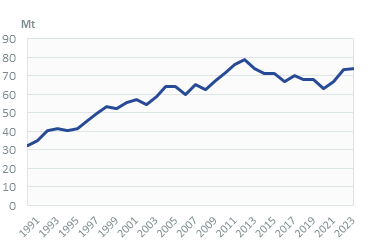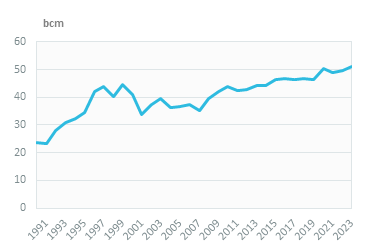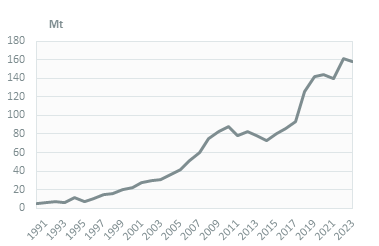-
-
 Energy and Climate Databases
Energy and Climate Databases- The most comprehensive and up-to-date annual energy database.
- Monitoring of technology providers in H2 supply chain.
- Monthly energy data on key energy markets.
- The most reliable and up-to-date power generation database.
- The essentials of LNG trade at your fingertips.
- Global monitoring of new and existing refineries.
- Analyse energy consumption and efficiency trends at world level. Benchmark countries.
- Have your database developed by a recognised expert of both energy and IT.
-
 Energy - Climate Forecasts
Energy - Climate Forecasts- Instant access to energy and emissions forecasts.
- Strategic, annual wholesale price projections backed by Enerdata's energy modelling expertise and our globally recognised POLES model.
- Wedges module showing a breakdown of the levers enabling to reduce emissions between two scenarios.
- Unique, independent projections of consumption by end-use.
- GHG Marginal Abatement Cost Curves.
- Benefit from proven models to draw your own energy scenarios and anticipate tomorrow’s challenges.
-
 Market Intelligence
Market Intelligence- 110 Energy and climate country reports
- A newsletter to receive the latest updates on evolving technologies and policies.
- Global energy news and analyses curated daily.
- Enerdata’s experts bring you the essentials about your market and competitors.
-
-
-
 Market Analysis
Market Analysis- Understanding key consumption trends and drivers across sectors.
- Granular and exclusive insight to address the most pressing business and strategic issues.
- Expertise in strategic and business intelligence, with fine-tuning to the market’s specificities.
-
 Energy - Climate Scenarios
Energy - Climate Scenarios- Providing the outlook of an energy commodity in mid to long term time horizons.
- Sector and driver specific energy demand forecasting.
- Assess the evolution of energy prices on the international and regional markets, as well as end-users prices.
- Enerdata guides you through pathways to reach climate targets.
- Supporting local authorities in their decarbonisation strategies.
-
 Climate Strategy and Policy Evaluation
Climate Strategy and Policy Evaluation- Cutting-edge quantitative tools and relevant indicators to monitor and evaluate evolutions on worldwide energy markets.
- Analysis of the most cost-effective options to reduce emissions.
- Quantified simulation and analysis of pledges for climate change negotiations.
- Breakdown and analysis of carbon markets.
- Enerdata guides you on the most beneficial policy or investment options.
- Turning climate objectives into concrete action plans.
-
 Training
Training- Understand different policy targets and measures on energy efficiency.
- How to measure energy savings?
- Energy Forecasting is a 2 days training to learn to design and interpret energy forecasts.
- Energy statistics training allowing to create energy balance with supply, transformation and consumption and understanding the international energy statistics regulations.
- Initiation to EnerMED level 1is the training to approach on the most powerful energy demand forecasting model.
-
-
Resource Centre
Indonesia Key Figures
- Population:
- 276 million
- GDP growth rate:
- 5.31 %/year
- Energy independence:
- 100%
Data of the last year available: 2022
- Total consumption/GDP:*
- 66.0 (2005=100)
- CO2 Emissions:
- 2.65 tCO2/capita
- Rate of T&D power losses:
- 8.57%
* at purchasing power parity
View all macro and energy indicators in the Indonesia energy report
Indonesia Related News
View all news, archive your new and create your own daily newsletters only on your topics/countries of interest with Key Energy Intelligence
Indonesia Related Research
Benefit from up to 2 000 up-to-date data series for 186 countries in Global Energy & CO2 data
A data overview is available in the global energy statistics app
Total Energy Consumption
Total consumption per capita is 0.93 toe, while electricity consumption per capita increased by nearly 13% in 2023, reaching 1.3 MWh.
Total energy consumption surged in 2022 (+16% vs 2021), after a decline of around 5% in 2020 and 2021. It increased by 3.4%/year from 2013 to 2019.
Interactive Chart Indonesia Total Energy Consumption
Benefit from up to 2 000 up-to-date data series for 186 countries in Global Energy & CO2 data
View the detailed fondamentals of the market at country level (graphs, tables, analysis) in the Indonesia energy report
Crude Oil Production
Oil production declined by 18% between 2019 and 2022, and reached 30.7 Mt in 2022. It increased by 3% in 2023. It had decreased by 44% between 2000 and 2015 from a peak of 70 Mt and rebounded by 5% in 2016. This decline is due to the depletion of the main fields and the lack of investments.
Indonesia became a net importer of crude oil in 2006. Net oil imports reached 39.5 Mt in 2022 (of which 14 Mt for crude oil and NGL).
Interactive Chart Indonesia Crude Oil Production
Benefit from up to 2 000 up-to-date data series for 186 countries in Global Energy & CO2 data
Additionally, for more detailed information on refineries, you can request a sample of our Asia Refineries Dataset
Oil Products Consumption
Oil consumption has been increasing since 2020 (+6%/year on average), reaching 75 Mt in 2022, after a decline of about 12% in 2020.
Transport absorbs 62% of that consumption; the remainder goes mainly to the residential, services, and agriculture sectors (14%), industry (10%), and the hydrocarbon sector (6%).
Graph: OIL CONSUMPTION (Mt)

Graph: OIL CONSUMPTION BREAKDOWN BY SECTOR (2022, %)
Interactive Chart Indonesia Refined Oil Products Production
Benefit from up to 2 000 up-to-date data series for 186 countries in Global Energy & CO2 data
Additionally, for more detailed information on refineries, you can request a sample of our Asia Refineries Dataset
Natural Gas Consumption
Natural gas consumption has been decreasing since 2020, reaching 38 bcm in 2022 (-1.2%/year on average), with a sharp decline in 2020 (-13%). It remained relatively stable over 2010-2019.
Industry is the largest consumer of gas (43%), followed by power generation with 33% and the hydrocarbon sector (oil and gas extraction and LNG plants) with 23%.
Graph: NATURAL GAS CONSUMPTION (bcm)

Graph: GAS CONSUMPTION BREAKDOWN BY SECTOR (2022, %)
Interactive Chart Indonesia Natural Gas Domestic Consumption
Benefit from up to 2 000 up-to-date data series for 186 countries in Global Energy & CO2 data
Additionally, for more detailed information on the LNG trade, you can request a sample of our Asia LNG Trade Dataset
Coal Consumption
Consumption of coal and lignite (around 85% lignite) experienced a dramatic surge in 2022, reaching 201 Mt (+36% vs 2021). It had increased very rapidly over 2013-2019 (+14%/year on average) and remained close to 145 Mt in 2019 and 2021.
The electricity sector accounts for 60% of coal and lignite consumption and the remainder goes to industry.
Graph: COAL CONSUMPTION (Mt)

Graph: COAL CONSUMPTION BREAKDOWN BY SECTOR (2022, %)
Interactive Chart Indonesia Coal and Lignite Domestic Consumption
Benefit from up to 2 000 up-to-date data series for 186 countries in Global Energy & CO2 data
View the detailed consumption trends at country level (graphs, tables, analysis) in the Indonesia energy report
Power Consumption
Electricity consumption has increased very rapidly apart from 2020 (by about 6.4%/year over 2010-2022), reaching 309 TWh in 2022.
Households account for 38% of the consumption. The share of industry is increasing and now accounts for 38% (+7 pts since 2015), and services for 23% (2022).
Almost all households are electrified (99.8% in 2022, up from 86% in 2000), in line with the 100% goal initially set for 2020 and shifted to 2022.
Graph: ELECTRICITY CONSUMPTION (TWh)
Renewable in % Electricity Production
EBTKE, the Directorate General (DG) for New Energy, Renewable and Energy Conservation, focuses on renewables in power generation, whereas the DG of Electricity sets the FiT and the ceiling price for power from renewable sources.
Interactive Chart Indonesia Share of Renewables in Electricity Production (incl hydro)
Benefit from up to 2 000 up-to-date data series for 186 countries in Global Energy & CO2 data
Learn more about renewables in the Mini grid Africa & Asia markets for village electrification
CO2 Fuel Combustion/CO2 Emissions
In its new updated NDC (2022), Indonesia slightly increased the country's unconditional emission reduction target from 29% in 2030 to 31.89% compared to the BAU scenario. Similarly, conditional emission reduction targets were raised from 41% to 43.2%, conditioned upon the attainment of global agreements such as bilateral co-operations, technology development and transfer, financial help, etc.